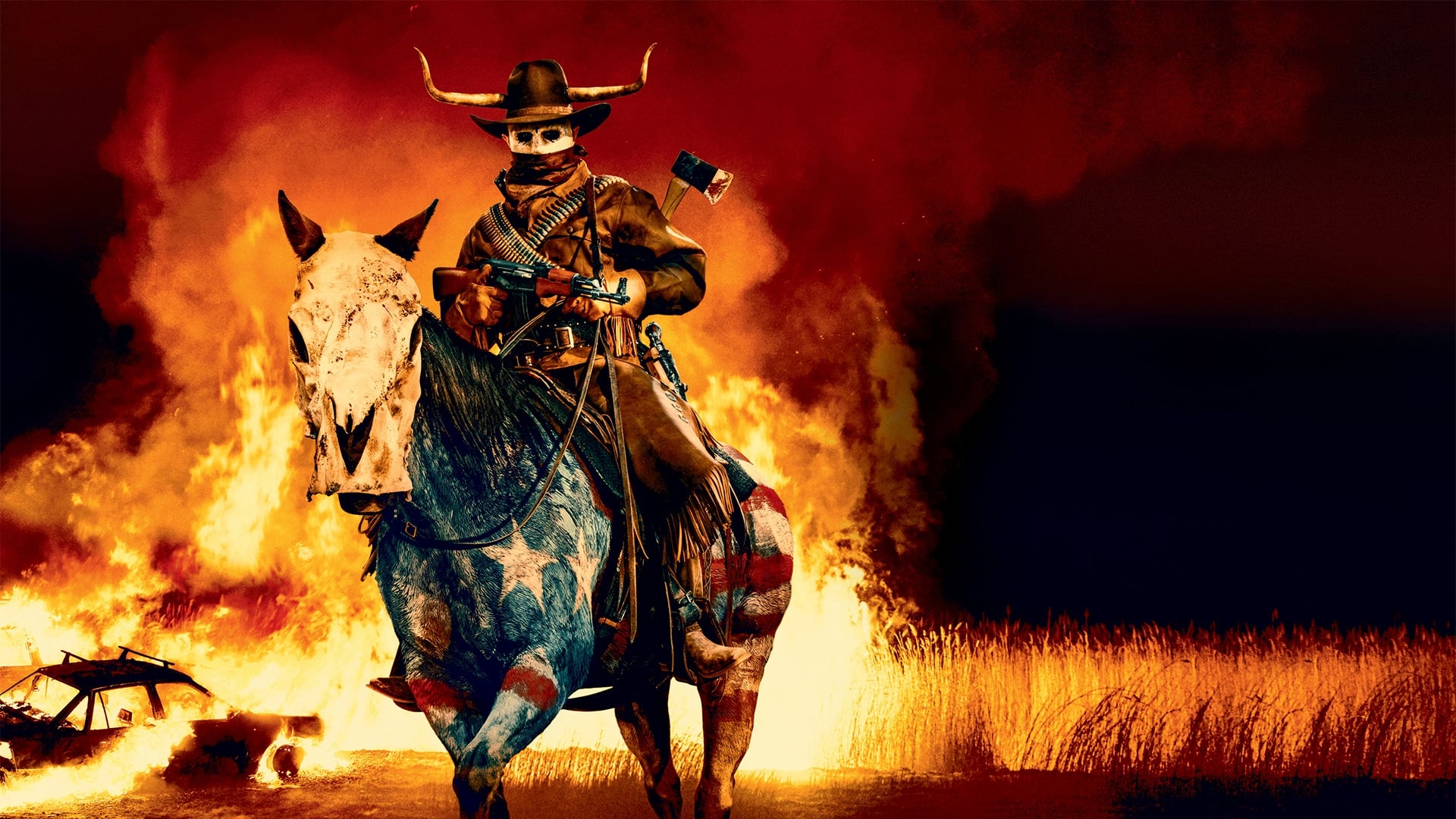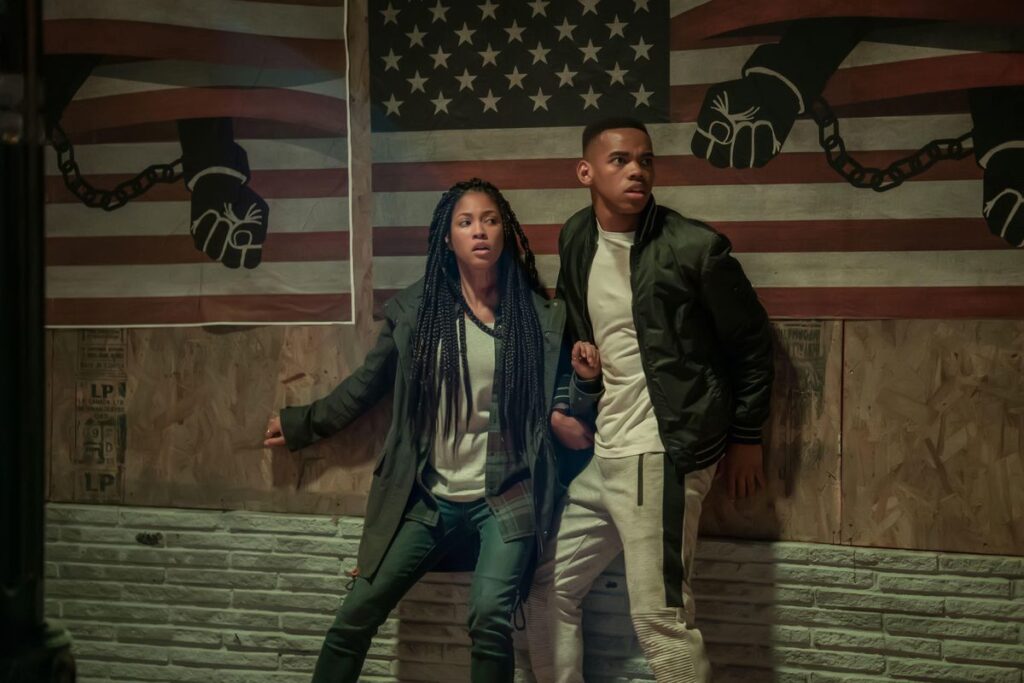
20 Oct The Purge: The Evolution into Revolutionary Horror
BY GABE CASTRO
“We will now purge. We will torture you and violate your flesh. Remove your skin and share in your blood. This is the American way.” – Uncle Sam (Purge: Election Year)
For nearly a decade, the fictional murderous release known as the Purge has been a part of our cinematic landscape. The evolution of the Purge franchise from home-invasion to political horror reflects our country’s own revolutionary fervor and political ails. Slowly expanding the universe’s lens and political imagery, the franchise shifted into intentional commentary that considers its BIPOC audiences–viewers who easily believe in a world that legalizes crime to further oppress their communities. The franchise ultimately reveals that everyday people don’t have a secret desire to commit crimes, and brings to light the true horrors of our society that BIPOC have always known: that those in power will use our pain and bodies to build their righteous world upon. Audiences weren’t equipped for a film like The First Purge or The Forever Purge in 2013, when complacency and comfort were expected and anyone asking for police reform or prison and ICE abolition were seen as radical, their arguments unfounded. The latest installments show us the growth of not only the series but of the audiences. After the volatile, tense summer of 2020, The Forever Purge is a close and expected reality.
In an interview in the LA Times, creator James DeMonaco spoke of the metamorphosis of the franchise from genre to political, saying, “I wanted to go into the [perspectives of] the disenfranchised, the impoverished and how the system is unhealthy. It was a metaphor for the predatory economics that we’ve seen over the years where we’re feeding the rich and taking from the poor.”

The Purge universe begins in a dystopian future of 2023. Once a year, for 12 hours, all crime is legal. “America. 2023. Unemployment is below 5%. Crime is virtually non-existent while every year fewer and fewer people live below the poverty line. All thanks to…the Purge.” This is revealed to be due to the calculated and strategic murder of lower-income BIPOC citizens during the Purge. At the helm of this genocidal annual event is the alt-right totalitarian political group, the New Founding Fathers. The Purge franchise is always violent and never subtle.
The NFFA (New Founding Fathers Association) wants America to believe that people are inherently evil. The flaw here and what The Forever Purge ultimately explores is that the people who are inclined to commit these murders are the same people who do so now without the guise of legality. It isn’t for lack of law that they commit these crimes but rather an expectation of privilege. Mimicking reality, these groups are motivated by their political leaders to believe their existence has more meaning than the communities they attack.
With a small budget of $3 million, DeMonaco scaled down his original vision of the premise. The Purge (2013), centers on a white upper-class family as they endure an onslaught of attacks from outside. For an audience of equal privilege to the family portrayed, the home invasion is terrifying in its own right–it’s a violation. It forces them to imagine a world in which the police wouldn’t come to their aid. A world where there are no safe systems in place to ensure survival, to ensure the American Dream. At the same time, in 2013, Black Lives Matter was just beginning to trend the #BlackLivesMatter hashtag after the murder of Trayvon Martin. There became an intense need to acknowledge white supremacist violence onto Black bodies. Starting small with protests on campuses, the fire of activism was igniting into something stronger.

After the success of the first film, DeMonaco was able to secure funding for the next films where he could explore the film’s ideology further. With The Purge: Anarchy (2014) and The Purge: Election Year (2016) DeMonaco began to lean into political commentary. In that same article in the LA Times, DeMonaco explains, “The people who respond the most to the Purge films are the African American audience and the Latino audience. They were the people who saw the films for what I’d always meant them to be.” The films were a loose attempt at highlighting the societal issues the Black and Brown audience members would be interested in seeing unfold on screen.
The Purge: Election Year was in post-production during the height of our nightmare of an election. The idea that Donald Trump and his right-wing followers would win the election and hold positions in our government was horror itself. Even Trump’s campaign slogan was the same as the tagline for the film. The parallel of a white woman career politician (Senator Charlie) being the last opposition for a tyrannical and racist party is unnerving. The filmmakers were beginning to see the merit in political horror. Audiences were in need of a cathartic release.
In 2014, Black Lives Matter became a nationally recognized group following the murders of Michael Brown and Eric Garner. Protests and unrest erupted in Ferguson, Missouri in retaliation to these tragedies. The group was growing stronger, and the understanding that this violence was systemic was becoming a bit more commonplace. Some audience members felt the same way about Senator Charlie as they did about Hilary Clinton: the country didn’t need another career politician to “fix” our problems. In 2016, Black Lives Matter became actively involved in the election and grew into a national network of over 30 local chapters. Still, mainstream views of the group remained less than positive, with many seeing them as too radical.

The First Purge (2018) finally shifts the franchise into a positive direction for BIPOC representation, possibly benefitting from the switch of directors from James DeMonaco to Gerard McMurray (Burning Sands). While the films before it dabbled in radical ideologies and history lessons, The First Purge is drenched in it. A character goes so far as to blurt out, “Pussy-grabbin’ motherfucker!” after an assault, referencing the disgusting audio uncovered of former-President, Donald Trump. The First Purge aims to shine a light on the populations the Purge was created to destroy. While we know our protagonists don’t win, after so many sacrificial deaths, reliving the same societal tragedies of black and brown bodily harm, there is catharsis in finally seeing characters fight back. The Purge will prevail but we finally get to see the faces of the true victims, in all their complexities and depth.
“I really think that the genre of horror lets us wrestle with the evils of our real world. I think that’s important. Horror films take [bad things] that occur in real life and turn it into a boogie man or something that we can conquer,” director McMurray explained.
Ending the franchise purposefully, The Forever Purge (2021) offers us a revolutionary answer to the Purge. We are offered the destruction of the Purge’s society, imploding at the hands of the very people the NFFA empowered. Even the rich white elite are victims of the monsters they gave validity to. This is what happens when you allow hate, prejudice, and racism to go not only unchecked but encouraged. The films began during the Obama administration and ended after Trump’s–the impact his administration had on the films is apparent. The Forever Purge features blatant caricatures of Trump supporters and right-wing nuts. “Ever After” purgers are clearly inspired by the horrible rhetoric Trump spread about undocumented people labeling them monsters, rapists, and murderers. Characters use racist slurs, have swastika tattoos, and spout white nationalist propaganda, “We will find you and disinfect you. America will be American once again.” They fawn over violence and gunfire; “Homegrown music from the heartland. That is American music, mother——!” yells the swastika-tattooed man.
Outrage against the violence of Black and Brown bodies came to a head last summer. Black Lives Matter became a household idea. Protests erupted across the nation after the murder of George Floyd. A Pew Research Center poll found that 67% of adult Americans expressed some support for the Black Lives Matter movement. It was no longer “too radical” to demand justice, seek police and incarceration reform, or riot against the systems that continue to oppress us–at least for a large majority of the country. The Forever Purge is benefitted by the reactionary nature of it. The beginning of the franchise played it safe while the end refused to shy away. It features intentional dialogue, characters, and situations that parrot the Trump administration and ends with criticizing the administration’s outlook on immigration and white nationalism.

Intentionally following the journey of an undocumented Mexican immigrant couple as they travel across the border (twice), the film is in deliberate opposition to the hatred ignited by a harmful political party. At the end of the film, Americans become immigrants fleeing to the safety of Mexico and Canada in fear of their own neighborhoods. While the “Ever-After” purgers take over the country, pushing the good non-purging Americans out, we are still left with a hopeful ending. These radicals not only destroy the country, but tear apart the ideology of the NFFA.
Do we need more Purge films, or can we instead make space for horror that empowers or features Black and Brown bodies not being brutalized by racists? Using films like this we can highlight some core problems within our own justice system. The Forever Purge takes place in our near-future and expresses the tension our society feels regarding each other. In a reality where angry right-wing anarchists can storm the capital because they’re upset with an election that ousted their fear-mongering, racist leader, viewers won’t miss the implications of the film–this is us, we’re living the Purge.
The film inspires us to revolutionize and abolish the systems that continue to benefit these people before they grow even more confident and self-righteous. We recognize that humans aren’t inherently evil, and that our form of the Purge is our prison industrial complex. We abolish ICE and acknowledge that BIPOC people aren’t the enemy here, but those in power constructing the narratives to validate murder are. The Purge franchise started with the attack on lower-income BIPOC communities and it ended by representing undocumented people who’ve suffered four years of demonization under Trump’s regime. Evolving from campy horror to intentional catharsis, I think it’s safe for us to retire the series on this note and make room for Black and Brown joy.
Where to watch:
The Purge (2013) – Rent on Apple TV, Vudu, or Amazon.
The Purge: Anarchy (2014) – Rent on Apple TV, Vudu, or Amazon.
The Purge: Election Year (2016) – Rent on Apple TV, Vudu, or Amazon.
The First Purge (2018) – Watch on Hulu; Rent on Apple TV, Vudu, or Amazon.
The Forever Purge (2021) – Rent on Apple TV, Vudu, or Amazon.

Gabe Castro is a Philadelphia-based multi-media creator specializing in the horror genre. By day, she works in public access television helping her community make people-powered media. By night, she is the producer and co-host of the horror media analysis podcast, Ghouls Next Door. She and fellow Ghoul, Kat, explore the unique and raw way society and culture influence film and media. Gabe believes media can be used as a tool to bring social change and works in all she does to create impactful and inspiring media. Gabe is also a co-host of the Black Tribbles, the award-winning geek talk radio show where she spends time with fellow BIPOC nerds. When she’s not hosting podcasts, she directs short horror comedies and designs terrifying soundscapes for the Black Women are Scary Podcast that celebrates people of color writing in horror.

Sorry, the comment form is closed at this time.